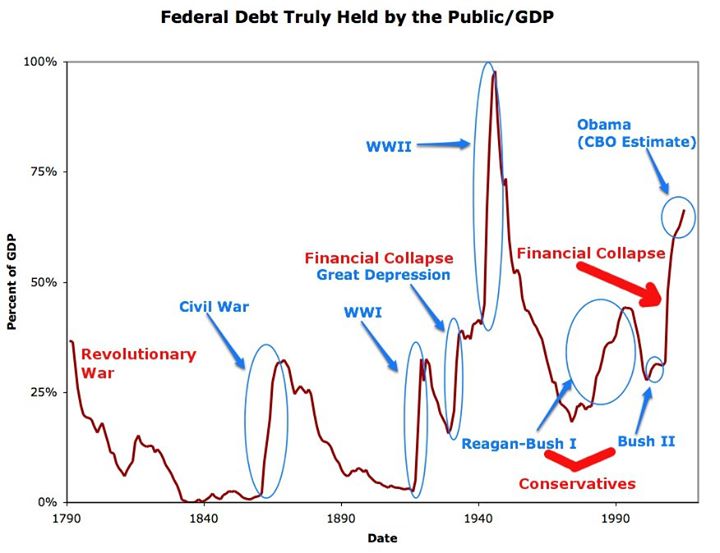Conservative Ideology Is A Debt Problem
For the first hundred years of American history, there was one cause of public debt: war. The United States of America started in debt, and it paid its bills. There wasn’t another spike in debt to Gross Domestic Product ratio until the American Civil War.
At this point, you might ask what is the debt to GDP ratio? It is the amount of our public debt compared to the size of our economy. That ratio is the number that economists care about.
It is not hard to understand. Your bank will lend you more money if they know you have a high income and high long-term earning potential. The bank will lend you less money at a higher interest rate if they know you have a low-income and low long-term potential.
During the American Revolutionary War, the Civil War and WWI, US debt rose to about 35% to 45% of annual GDP. The Fourteenth Amendment is clear that Congress has a duty to pay the debts: “The validity of the public debt of the United States, authorized by law, including debts incurred for payment of pensions and bounties for services in suppressing insurrection or rebellion, shall not be questioned.”
When Congress passes a budget, it authorizes the President to incur debt to pay bills beyond the amount collected from taxes. A 1917 law theoretically places a limit on how much debt the US government can borrow.
That law has never been tested in court. Every time the USA has approached that limit Congress has always voted to pay its bills. For this reason, investors worldwide consider US public debt as one of the safest investments in the world.
During the Great Depression, Franklin Delano Roosevelt convinced Congress to take on more debt for public works projects like schools, airports, dams, and bridges. Conservatives cried in frustration. They had already failed to end skyrocketing joblessness by trying to balance the budget.
FDR’s New Deal put America in a good position heading into the Second World War. The economy was on the right track and became the Arsenal for Democracy. American factories used borrowed money to manufacture the tanks, planes and ships needed to beat back tyranny.
When the war ended, neither Democrats nor Republicans wanted to return to the failed economic policies that lead to, and prolonged, the Great Depression. America taxed the wealthiest citizens and rewarded wage earners. A strong economy produced more taxes that paid down the debt from the Great Depression and the War. The debt to GDP ratio fell from 115% to 35%.

Not until the 1980s did a third cause of debt emerge in American history. Ronald Reagan led a conservative revolution to reverse the previous fifty years of taxing the rich to pay for government services. He cut taxes for the rich and services for everyone else. Reagan’s deficits drove the national debt to GDP ratio up from 35% to 45%.
The lessons from this history are clear. Use diplomacy and alliances to reduce unnecessary wars. Effectively regulate financial markets to stop them from burning the economy down. Ignore conservative politicians who claim tax cuts and deregulation will balance the budget.
Comments
You must be logged in to post a comment.